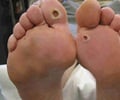According to a study, intensive control of glucose reduces the complications of longstanding type 1 diabetes by fifty percent.
The researchers behind it found that near-normal control of glucose beginning as soon as possible after diagnosis would greatly improve the long-term prognosis of type 1 diabetes.The study also found that the outlook for people with longstanding type 1 diabetes has greatly improved in the past 20 years due to a better understanding of the importance of intensive glucose control as well as advances in insulin formulations, insulin delivery, glucose monitoring, and the treatment of cardiovascular risk factors.
"The demonstration that near-normal glucose control substantially lowers microvascular and cardiovascular complications has heralded a new era of type 1 diabetes care," said lead author Dr. David M. Nathan, of Massachusetts General Hospital.
Nathan is also co-chair of the landmark Diabetes Control and Complications Trial (DCCT) and its follow-up study, the Epidemiology of Diabetes Interventions and Complications (EDIC).
"The remarkable improvement in long-term outcomes achieved with intensive glucose control should encourage clinicians and patients alike to implement intensive therapy as early in the course of type 1 diabetes as possible," he added.
The DCCT, conducted from 1983 to 1989, found that intensive glucose control was superior to conventional control in delaying or preventing the complications of type 1 diabetes.
Advertisement
For the study, the researchers compared overall rates of eye, kidney, and cardiovascular complications in three groups of people diagnosed with type 1 diabetes an average of 30 years earlier.
Advertisement
The third group was a subset of patients in the Pittsburgh Epidemiology of Diabetes Complications (EDC) study, who were matched to DCCT/EDIC participants by age, duration of diabetes, and degree of eye damage.
It was found that after 30 years of diabetes, DCCT participants randomly assigned to intensive glucose control had about half the rate of eye damage compared to those assigned to conventional glucose control (21 percent vs. 50 percent).
They also had lower rates of kidney damage (9 percent vs. 25 percent) and cardiovascular disease events (9 percent vs. 14 percent) compared to those receiving conventional glucose control.
In addition, the intensively treated DCCT group had lower complication rates than EDC participants, whose rates were similar to DCCT's conventional control group: eye damage (47 percent), kidney damage (17 percent), and cardiovascular disease events (14 percent).
Not only did intensive glucose control halve the rates of eye and kidney damage, but also the rates of vision loss and kidney failure were much lower than had been seen historically.
The study has been published in a recent issue of the Archives of Internal Medicine, which updates information about the clinical course of type 1 diabetes.
Source-ANI
ARU















